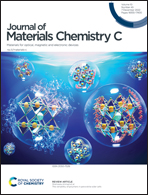The GaPS2Se2 monolayer: a novel stable 2D Janus semiconductor with anisotropic properties for spontaneous water splitting under the irradiation of solar light†
Abstract
Considering the issues of energy shortage and global warming in the near future, developing sustainable and CO2 emission-free energy sources is necessary for industrialization and civilization. Pure hydrogen is a promising source of clean energy due to its high energy density and sustainable production. In this regard, using density functional theory calculations, a novel two-dimensional (2D) Janus material GaPS2Se2 is predicted to be a promising candidate for the photocatalytic water-splitting application to produce hydrogen. After ascertaining its stability, it was found that the new material shows an anisotropic Young's modulus (Poisson's ratio) of 9.04–29.09 N m−1 (0.05–0.34). Notably, the GaPS2Se2 Janus material shows a moderate direct bandgap of 2.64 eV and anisotropic carrier mobilities for electrons (284.61/37.60 cm2 V−1 S−1) and holes (528.83/550.63 cm2 V−1 S−1), making it suitable for the photocatalytic water splitting catalyst. Interestingly, when applying strain-engineering modulation, the electronic properties, effect mass, and optical properties can be well-tuned. Importantly, both oxygen evolution and hydrogen evolution can spontaneously occur at pH = 3 and 2% tensile strain by calculating the Gibbs free energy of each intermediate. Through systematic investigations, the GaPS2Se2 monolayer is a promising candidate for electronics, photoelectronics, and photocatalytic water splitting applications.



 Please wait while we load your content...
Please wait while we load your content...